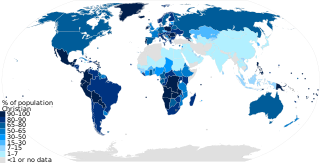
The Catholic Church in Benin is part of the worldwide Catholic Church, under the spiritual leadership of the Pope in Rome.

Christianity in Albania was established throughout the country in 325 AD. From 1100 AD, the Roman Empire carried out Church missions in the area. In relation to the increasing influence of Venice, the Franciscans started to settle down in the area in the 13th century. From the 15th century to the 19th century, under the rule of the Ottoman Empire, Christianity was replaced by Islam as the majority religion in Albania during the Ottoman Empire.

As of the year 2023, Christianity had approximately 2.6 billion adherents and is the largest-religion by population respectively. According to a PEW estimation in 2020, Christians made up to 2.6 billion of the worldwide population of about 8 billion people. It represents nearly one-third of the world's population and is the largest religion in the world, with the three largest groups of Christians being the Catholic Church, Protestantism, and the Eastern Orthodox Church. The largest Christian denomination is the Catholic Church, with 1.3 billion baptized members. The second largest Christian branch is either Protestantism, or the Eastern Orthodox Church.
The Catholic Church in Guinea is part of the worldwide Catholic Church, under the spiritual leadership of the pope.

The Catholic Church in Indonesia is part of the worldwide Catholic Church, under the spiritual leadership of the pope in Rome. Catholicism is one of the six approved religions in Indonesia, the others being Islam, Protestantism, Hinduism, Buddhism, and Confucianism. According to official figures, Catholics made up 3.12 percent of the population in 2018. The number of Catholics is, therefore, more than 8.3 million. Indonesia is primarily Muslim, but Catholicism is the dominant faith in certain areas of the country.

The Catholic Church in Guyana is part of the worldwide Catholic Church, under the spiritual leadership of the Pope in Rome. Bishops in Guyana are members of Antilles Episcopal Conference. Like most other nations that form the AEC, the Apostolic delegate to the bishops' conference is also the Apostolic nuncio to the country, currently American archbishop Thomas Edward Gullickson.

The Catholic Church in Kazakhstan is part of the worldwide Catholic Church, under the spiritual leadership of the pope in Rome.

The Catholic Church in Niger is part of the worldwide Catholic Church, under the spiritual leadership of the Pope in Rome.
The Archdiocese of Lusaka is a Latin Church ecclesiastical territory or archdiocese of the Catholic Church in Zambia, where it is also considered its national primatial see.

Christianity in Kazakhstan is the second most practiced religion after Islam.

Eritrea as a country and the Eritrean community are multi-religious. Eritrea has two dominant religions, Christianity and Islam.

Christianity in Nigeria accounted for an estimated 46.18% of the Nigerian population in 2020; two-thirds of Christians in Nigeria are Protestant.

The predominant religion in Kenya is Christianity, which is adhered to by an estimated 85.5% of the total population. Islam is the second largest religion in Kenya, practised by 10.9 percent of Kenyans. Other faiths practised in Kenya are Baháʼí, Buddhism, Hinduism and traditional religions.

Christians in Benin constitute approximately 48.5 of the country's population.

Christianity is the predominant religion in Zambia and is recognised as the state religion by the country's constitution. Before the arrival of European missionaries, the various ethnic groups residing in the territory of modern day Zambia practiced a variety of African traditional religions.
According to the 2012 census, Islam is the most followed religion in Niger and is practiced by 99% of the population. According to Pew, roughly 80% of Muslims are Sunni of Maliki school of jurisprudence, whilst 20% are non-denominational Muslims Other religions practiced in Niger include Animism and Christianity.

Haiti is a majority Christian country. Figures in 2020 suggest that 93% of the population belong to a Christian denomination.
The Zambia Conference of Catholic Bishops, known before 2016 as the Zambia Episcopal Conference (ZEC) was established in 1965. The statutes of the Conference were approved by the Holy See on April 2, 1984. The ZCCB is a member of the Association of Member Episcopal Conferences in Eastern Africa (AMECEA) and Symposium of Episcopal Conferences and of Africa and Madagascar (SECAM).
The Apostolic Vicariate of Bangueolo was a vicariate established by the Catholic White Fathers missionary society in 1913 located in what is now Zambia.











